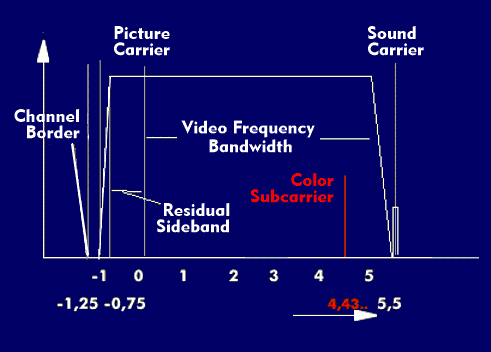audio carrier
In television, sound and picture are modulated using different modulation methods and transmitted together. To ensure that the sound signal does not cause interference in the television picture, the audio signal is modulated onto a sound carrier frequency that is outside the frequency spectrum of the television picture.
In the PAL television standard, the sound carrier frequency is 5.5 MHz, which means that the picture/sound carrier spacing is 5.5 MHz. The stereophonic sum signal of the right and left channels is transmitted on this carrier frequency of 5.5 MHz so that television sets that do not support stereophony can reproduce both audio channels in the mono signal. On another subcarrier, located at 5.7421875 MHz, the audio signal of the right channel is transmitted for stereo. From the sum signal and the signal for the right audio channel, the two stereo signals for the left and right channels are obtained. This allows stereo to be reproduced in stereophonic televisions. This technique is called two-channel sound or A2.
In order for the television to detect whether the signal is monophonic or stereophonic, the subcarrier of 5.74 MHz is amplitude modulated at a frequency of 54.6875 kHz, which is 3.5 times the line frequency of 15.625 kHz. The subcarrier of 54.6 kHz is modulated with an identification tone of 117.5 Hz for stereo transmissions, 235.5 Hz for twin mono signals, and is not modulated for mono signals. The first frequency corresponds to 1/133 of the line frequency, the second to 1/66.
In satellite transmission, multiple audio subcarriers are provided for audiotransmission for stereophony or for multilingual transmissions.

